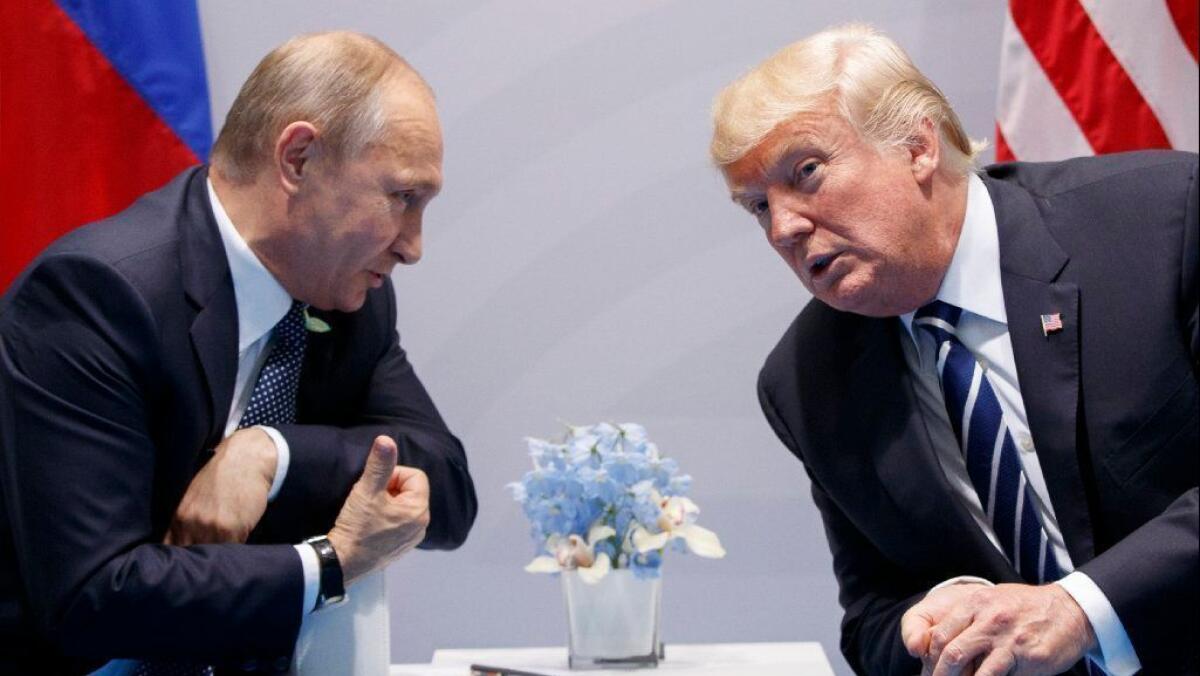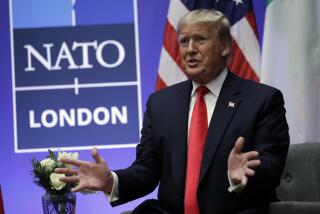Trump and Putin to meet in Finland amid European fears of shifting alliances

President Trump and his Russian counterpart, Vladimir Putin, announced that they will meet in Helsinki, Finland, on July 16, a long-anticipated summit of friendly rivals that occurs amid an American criminal inquiry into Russia’s election interference and concerns that the United States is drifting from its traditional allies.
Even as the announcement went out Thursday morning, Trump signaled a partiality toward Russia that belies its many conflicts with the United States. On Twitter, he noted Russia’s insistence that it “had nothing to do with Meddling in our Election,” seemingly accepting that claim over the opposite, unanimous assessment of U.S intelligence agencies that Moscow intervened in the 2016 campaign to boost Trump.
Trump, in several tweets, also aired his grievances with the Russia inquiry, which has hung ominously over his presidency. Special counsel Robert S. Mueller III also is investigating whether the Trump campaign colluded with Russia and whether Trump sought to obstruct the inquiry.
“There was no Collusion and the Witch Hunt, headed by 13 Angry Democrats and others who are totally conflicted, is Rigged!” Trump wrote.
His online posts seemed timed to preview a House hearing at which Trump’s Republican allies intended to confront Rod Rosenstein, the deputy attorney general who is overseeing the inquiry, and FBI Director Christopher Wray, whose agency has been at the center of it.
A summit between Trump and Putin has been talked about since Trump’s election, yet the controversies surrounding the Russia investigation as well as differences over conflicts in Ukraine and Syria complicated any planning. The two leaders met briefly, and amicably, last year during an international conference in Hamburg, Germany, but this will be their first full summit.
“The two leaders will discuss relations between the United States and Russia and a range of national security issues,” White House Press Secretary Sarah Huckabee Sanders said in a brief statement.
The Trump-Putin session will follow the U.S. president’s summit in Belgium with North Atlantic Treaty Organization partners, who have been worried that Trump has sparred with traditional allies in Europe over trade, environmental and military policies while speaking warmly of Putin and praising his authoritarian rule. In between, Trump will visit Britain, another longtime ally that has seen its relationship chill during his administration.
European partners and American critics are concerned that Trump will move closer to Putin, who is viewed as a major adversary by much of the Western European and U.S. foreign policy establishment.
Trump, though he has imposed sanctions on Russia for its election meddling and other hostile actions, has maintained that the country could be a partner in solving problems in Syria, North Korea and other global hot spots.
He raised hackles this month when he said Russia should be invited to rejoin the Group of 7 leading industrialized nations, returning it to the Group of 8. The alliance ousted Russia after its takeover of Crimea in 2014. American and allied officials continue to accuse Russia of backing separatists in eastern Ukraine, and earlier this year, Britain charged Moscow with the attempted assassination there of a former Russian spy and his daughter.
“I’ve said it from Day One: Getting along with Russia and with China and with everybody is a very good thing,” Trump told reporters Wednesday while meeting with Portuguese President Marcelo Rebelo de Sousa. “It’s good for the world, it’s good for us, it’s good for everybody.”
It’s not unusual for American presidents to meet with their Russian counterparts amid tensions. Notable summits took place with the former Soviet Union throughout the Cold War and, after its breakup in the early 1990s, continued with Russia. Allies are worried, however, that Trump will repeat his performance earlier this month, when he had a provocative meeting with G-7 allies in Canada followed by a higher-profile summit with North Korean leader Kim Jong Un, a meeting at which he seemed more comfortable and accommodating.
“There’s no good time to meet with Putin around the NATO summit,” said Elisabeth Braw, a London-based fellow at the Center for European Policy Analysis who specializes in European security issues.
The NATO alliance was established by the United States during the Cold War to serve as a bulwark against Russian military aggression in Europe, but Trump has questioned its relevance — he later reaffirmed it — and continues to attack its members as defense deadbeats, unwilling to pay their share of the burden.
The concern is that “he leaves unhappy with America’s allies and essentially makes up for that by perhaps agreeing to too much,” Braw said.
Like Kim in North Korea, Putin wants the legitimacy that comes with “being back at the top table” with an American president, without addressing controversies such as Crimea or the hacking of American elections, said Alexander Vershbow, who served as a deputy secretary general of NATO as well as a U.S. ambassador to both NATO and Russia.
He said the United States should have gotten “even modest agreements nailed down before you actually set the date for the summit, so it doesn’t just turn into a photo op where Putin gets to tell his people he stared the Americans down.”
One European diplomat based in Washington, who requested anonymity to speak candidly, said that “on the substance, one has to recognize that the relationship between Russia and the [NATO] alliance is a difficult one and is something that can be very divisive within the organization.”
Even so, the diplomat said, there is the potential that Trump can alleviate some of that tension, even if the relationship never returns to its high point immediately after the Cold War. In that period, Russia opened itself to democratic and economic reforms, until Putin came to power.
“We need to have, at the one hand, a robust deterrence and defense against Russia,” the diplomat said. “But on the other hand, we should always try to have also a political dialogue with Russia, because, geographically, they are where they are.”
Follow the latest news of the Trump administration on Essential Washington »
Yuri Ushakov, an aide to Putin, told reporters Wednesday that the format for the Trump-Putin meeting will include standard protocols: a tete-a-tete between the presidents and a joint news conference.
After the meeting, he said, the two presidents may adopt a joint statement “that could outline further steps on both sides in terms of improving bilateral relations, terms for joint actions in the international arena and terms for ensuring international stability and security,” according to Tass, the Russian state news agency.
Tass said that the idea of the Trump-Putin summit first arose in a March 20 phone call between the two presidents. Trump initiated that call after Putin’s reelection in a vote condemned internationally as a sham, and congratulated him despite briefing papers saying “DO NOT CONGRATULATE.”
The issue of the summit was then discussed through “closed channels,” Tass reported, citing the Kremlin news service.
Trump’s national security advisor, John Bolton, has been in Russia this week, negotiating the details of the summit.
The date would allow Putin to attend the final match of the World Cup, which his country is hosting, before meeting Trump.
Special correspondent Sabra Ayres in Moscow contributed to this report.
Twitter: @noahbierman
UPDATES:
10:45 a.m.: This article was updated with additional context, Trump tweets and analysis from foreign policy experts.
This article was originally published at 5:45 a.m.
More to Read
Get the L.A. Times Politics newsletter
Deeply reported insights into legislation, politics and policy from Sacramento, Washington and beyond. In your inbox three times per week.
You may occasionally receive promotional content from the Los Angeles Times.






